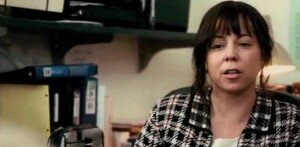Disney’s first black fairy tale: More frog than princess
Culture, Pop culture — By Sophia A. Nelson Esq. on December 29, 2009 at 12:13It was déjà vu all over again for me. It was Christmas, my two young bi-racial nieces were in town for Christmas and we decided to all go see Disney’s new “ Princess & the Frog” movie. To be candid, I thought it was the worst fairy tale I have ever seen in my life. I walked away disturbed and frankly dismayed as a modern 21st century black woman.

Courtesy of Disney.
The problem with this movie (and there were many) is that it was Disney’s first black fairy tale, and like many of you I was eager to see a black girl land her Prince, live in a big palace, have servants, dance at the ball, and live happily ever after.
Boy was I disappointed.
I was deeply troubled by the images of black 1920s & 30’s New Orleans segregation and economic deprivation, a black father who worked hard and died too young, black spinsters, voodoo priestesses, smarmy black male charlatans, a Prince who was not black but from India or some other place from afar – oh, and by the way, the Prince is broke ya’ll. Say what?? I said the Prince is broke and has to get a job because his parents disowned him. Isn’t that just wrong?!
My brother and I just kept looking at each other during the movie, shaking our head. Then, when the young lady turned into a frog when she kissed the frog—I was through—too through. Yes, in the end she gets her Prince and she is a Princess, but did I mention the Prince was broke? Yup that’s right, no money at all.
This movie seemed to be released with perfect timing as we now have a glamorous black first family & lovely brown skinned first lady in the White House. We watch them live out the real life version of the Cosby decade that so many of us came of age in during the 1980s and early 1990s every day on our TV’s. And as black women, particularly as accomplished black women we all take great pride and joy in seeing Michelle have a very successful handsome black man who can give her everything she ever dreamed of.
Finally, much like my dismay over Disney’s 2007 Enchanted, where the pretty white cartoon fairy tale princess becomes a real life figure (Amy Adams) who finds herself lost in New York City falling in love with a single-dad lawyer (Patrick Dempsey), the images in the Princess and the Frog were also stereotypical and degrading of black women. In Enchanted you had two angry, large sized irate black women – one yelling at the Prince and threatening him with violence on a bus, the other angrily seeking a divorce.
In Princess, all the images are re-ingrained into a new generation of black girls psyche—single attractive black woman, works hard, wants a business, can’t afford it, gets swindled, is alone, does not date, has no fun, is stoic, stern, a chastening rod for the frivolous playboy Prince, ends up in the swamps as an ugly frog, running for her life from evil, broken dreams, etc. Is there any need to go on?
In the final analysis, I am proud of Anika Noni Rose for landing this historic role, and I understand that this movie is set in a segregated 1930s southern timeframe—BUT, our little girls deserve better than the same old work hard, be a strong black woman, men aren’t important, I can make my dreams come true alone without any help nonsense that has wrecked so many of us to this very day.
Tags: black girls, black women, disney, film, movies, princess and the frog, review, Talking about Race, WomenAuthor: Sophia A. Nelson Esq. (4 Articles)

Sophia is a popular blogger, and political/social commentary opinion writer who has been published in The Washington Post, New York Times, Politico, The Root.com, Essence.com, Legal Times, & The Wall Street Journal. She has been quoted by a variety of media outlets as a political analyst and is a regular guest contributor to XM’s POTUS08, FoxNews, CNN, CNN International, NPR, WHUR, and BET where she dissects and debates the important issues of the day, ranging from the grassroots, to Presidential politics and public policy formation on Capitol Hill. As a former Senate Intern, RNC Intern, State Legislature Aide, Regulatory Counsel to NJ Governor Christie Whitman, Congressional Candidate, & Investigative Counsel to the House Republican Majority Staff/Government Reform Committee in the late 1990s Nelson has had an up close view of the inner workings of the nation’s capital and a front row seat to the political battles that make national news.



 Share This
Share This Tweet This
Tweet This Digg This
Digg This Save to delicious
Save to delicious Stumble it
Stumble it





 Mississippi Chicken production stills
Mississippi Chicken production stills Not just Guantanamo: U.S. torturing Muslim pre-trial detainee in New York City
Not just Guantanamo: U.S. torturing Muslim pre-trial detainee in New York City Alessandra Soler-Meetze and Immigration in Arizona
Alessandra Soler-Meetze and Immigration in Arizona Poverty of the Spirit and Mind
Poverty of the Spirit and Mind








2 Comments
I’m sorry, but this article is ridiculous. First, the vast majority of your assumptions about the film could have been debunked by simply watching the theatrical trailer. If you were truly cautious or skeptical about Disney films, you would have done this first before seeing the picture.
Second, why expect a major motion picture produced in the 2000s to fit the bland, prefictible template you laid out in your expectations? Of you desire to show your children something so tame and safe, there are plenty of bargain basement quality DVDs awaiting your purchase. The prince is broke; how horrible! But the fact that he IS broke, and a flawed character, is one of the things that interested the vast majority if people I know –
including myself, a black man, and my friend, a black woman – who saw the picture and liked it.
As for the “poor hard working woman” aspect of the film, it’s a standard itself of Disney films, going back to Snow White in 1937. The production staff haven’t singled out the black princess in some attempt to cheapen her fairy tale dreams.
It’s interesting that you felt offended as a “modern 21st century black woman” because the film didn’t adhere to standard 17th century fairy tale values. Cinema, especially cinema involving black characters, doesn’t need to exist in a vacuum, not even for family-oriented films.